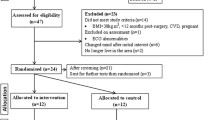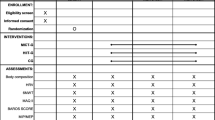Abstract
Purpose
The aim of this study is to conduct a pilot randomized trial testing an exercise program specifically adapted for post-bariatric patients.
Methods
A total of 51 post-bariatric patients, 6–24 months post-surgery, were randomly assigned to usual care control (n = 25) or the exercise intervention (n = 26). The intervention included twice weekly 60-min group exercise classes with functional strength, flexibility, and aerobic activities; at least 3 days per week of self-directed exercise; daily pedometer; recording of steps and activities; and weekly telephone counseling. There was also a 6-month maintenance period.
Results
Patients were 49 ± 12 years old, 84 % female, 59 % non-Hispanic white, with a BMI of 32.9 ± 5.7 kg/m2 and percent excess BMI loss since surgery of 56 ± 35 %. Patients were 14 ± 5 months post-surgery. A total of 44 patients (86 %) completed both phases of the program and all assessments. The following measures improved significantly for intervention participants with no significant change in control participants: yards walked in 6 min, seconds for 8-foot up-and-go, number of arm curls, and distance in inches for chair sit-and-reach. Intervention changes remained after 6 months of maintenance.
Conclusions
When compared to patients in usual care, a specially adapted exercise program for post-bariatric patients resulted in significant improvements in objectively monitored health outcomes. This program was delivered in a clinical setting and could be implemented in a variety of settings to improve health outcomes for post-bariatric patients.

Similar content being viewed by others
References
Ribaric G, Buchwald JN, McGlennon TW. Diabetes and weight in comparative studies of bariatric surgery vs conventional medical therapy: a systematic review and meta-analysis. Obes Surg. 2014;24(3):437–55. Pubmed Central PMCID: PMC3916703.
Kinzl JF, Schrattenecker M, Traweger C, et al. Psychosocial predictors of weight loss after bariatric surgery. Obes Surg. 2006;16(12):1609–14.
Pontiroli AE, Fossati A, Vedani P, et al. Post-surgery adherence to scheduled visits and compliance, more than personality disorders, predict outcome of bariatric restrictive surgery in morbidly obese patients. Obes Surg. 2007;17(11):1492–7.
Toussi R, Fujioka K, Coleman KJ. Pre- and postsurgery behavioral compliance, patient health, and postbariatric surgical weight loss. Obesity (Silver Spring, Md). 2009;17(5):996–1002.
King WC, Hsu JY, Belle SH, et al. Pre- to postoperative changes in physical activity: report from the longitudinal assessment of bariatric surgery-2 (LABS-2). Surg Obes Relat Dis. 2012;8(5):522–32. Pubmed Central PMCID: PMC3248952.
Livhits M, Mercado C, Yermilov I, et al. Exercise following bariatric surgery: systematic review. Obes Surg. 2010;20(5):657–65. Pubmed Central PMCID: 2850994.
Mechanick JI, Kushner RF, Sugerman HJ, et al. American Association of Clinical Endocrinologists, The Obesity Society, and American Society for Metabolic & Bariatric Surgery medical guidelines for clinical practice for the perioperative nutritional, metabolic, and nonsurgical support of the bariatric surgery patient. Obesity (Silver Spring, Md). 2009;1:S1–70, v.
Baillot A, Mampuya WM, Comeau E, et al. Feasibility and impacts of supervised exercise training in subjects with obesity awaiting bariatric surgery: a pilot study. Obes Surg. 2013;23(7):882–91.
Parikh M, Dasari M, McMacken M, et al. Does a preoperative medically supervised weight loss program improve bariatric surgery outcomes? A pilot randomized study. Surg Endosc. 2012;26(3):853–61.
Castello V, Simoes RP, Bassi D, et al. Impact of aerobic exercise training on heart rate variability and functional capacity in obese women after gastric bypass surgery. Obes Surg. 2011;21(11):1739–49.
Nijamkin MP, Campa A, Sosa J, et al. Comprehensive nutrition and lifestyle education improves weight loss and physical activity in Hispanic Americans following gastric bypass surgery: a randomized controlled trial. J Acad Nutr Diet. 2012;112(3):382–90.
Shah M, Snell PG, Rao S, et al. High-volume exercise program in obese bariatric surgery patients: a randomized, controlled trial. Obesity (Silver Spring, Md). 2011;19(9):1826–34.
Zagarins SE NAA, Skinner SS, Kepmer AJ, et al. Improved exercise behaviors associated with a comprehensive structured exercise program following bariatric surgery. Bariatr Nurs Surg Patient Care. 2011;6(2):85–90.
Stegen S, Derave W, Calders P, et al. Physical fitness in morbidly obese patients: effect of gastric bypass surgery and exercise training. Obes Surg. 2011;21(1):61–70.
Herring LY, Stevinson C, Davies MJ, et al. Changes in physical activity behaviour and physical function after bariatric surgery: a systematic review and meta-analysis. Obes Rev. 2016. doi:10.1111/obr.12361.
Levy SS, Macera CA, Hootman JM, et al. Evaluation of a multi-component group exercise program for adults with arthritis: fitness and exercise for people with arthritis (FEPA). Disabil Health J. 2012;5(4):305–11.
Coleman KJ, Huang YC, Hendee F, et al. Three-year weight outcomes from a bariatric surgery registry in a large integrated healthcare system. Surg Obes Relat Dis. 2014;10:396–403.
Josbeno DA, Jakicic JM, Hergenroeder A, et al. Physical activity and physical function changes in obese individuals after gastric bypass surgery. Surg Obes Relat Dis. 2010;6(4):361–6.
Podsiadlo D, Richardson S. The timed “Up & Go”: a test of basic functional mobility for frail elderly persons. J Am Geriatr Soc. 1991;39(2):142–8.
Jones CJ, Rikli RE, Beam WC. A 30-s chair-stand test as a measure of lower body strength in community-residing older adults. Res Q Exerc Sport. 1999;70(2):113–9.
Jones CJ, Rikli RE, Max J, et al. The reliability and validity of a chair sit-and-reach test as a measure of hamstring flexibility in older adults. Res Q Exerc Sport. 1998;69(4):338–43.
Lawrence RH, Jette AM. Disentangling the disablement process. J Gerontol B Psychol Sci Soc Sci. 1996;51(4):S173–S82.
Laska MN, Murray DM, Lytle LA, et al. Longitudinal associations between key dietary behaviors and weight gain over time: transitions through the adolescent years. Obesity (Silver Spring, Md). 2012;20(1):118–25. Pubmed Central PMCID: PMC3402912.
Yore MM, Ham SA, Ainsworth BE, et al. Reliability and validity of the instrument used in BRFSS to assess physical activity. Med Sci Sports Exerc. 2007;39(8):1267–74.
Trofa D, Smith EL, Shah V, et al. Total weight loss associated with increased physical activity after bariatric surgery may increase the need for total joint arthroplasty. Surg Obes Relat Dis. 2014;10:335–9.
Zabatiero J, Hill K, Gucciardi DF, Hamdorf JM, Taylor SF, Hagger MS, Smith A. Beliefs, barriers and facilitators to physical activity in bariatric surgery candidates. Obes Surg. 2015
Coleman KJ, Raynor HR, Mueller DM, et al. Providing sedentary adults with choices for meeting their walking goals. Prev Med. 1999;28(5):510–9.
Kulik C, Kulik J, Bangert-Drowns R. Effectiveness of mastery learning programs: a meta-analysis. Rev Educ Res. 1990;60(2):265–306.
Michie S, Abraham C, Whittington C, et al. Effective techniques in healthy eating and physical activity interventions: a meta-regression. Health Psychol. 2009;28(6):690–701.
Neves LM, Fortaleza AC, Rossi FE, Diniz TA, Codogno JS, Gobbo LA, Gobbi S, Freitas Júnior IF. Functional training reduces body fat and improves functional fitness and cholesterol levels in postmenopausal women: a randomized clinical trial. J Sports Med Phys Fit. 2015
Muller-Riemenschneider F, Reinhold T, Nocon M, et al. Long-term effectiveness of interventions promoting physical activity: a systematic review. Prev Med. 2008;47(4):354–68.
Wing RR, Papandonatos G, Fava JL, et al. Maintaining large weight losses: the role of behavioral and psychological factors. J Consult Clin Psychol. 2008;76(6):1015–21. Pubmed Central PMCID: 2677901.
Wing RR, Tate DF, Gorin AA, et al. A self-regulation program for maintenance of weight loss. N Engl J Med. 2006;355(15):1563–71.
Tudor-Locke C, Craig CL, Brown WJ, et al. How many steps/day are enough? For adults. Int J Behav Nutr Phys Act. 2011;8:79. Pubmed Central PMCID: PMC3197470.
Author information
Authors and Affiliations
Corresponding author
Ethics declarations
Conflict of Interest
The authors declare that they have no conflicts of interest.
Ethical Approval
All procedures performed in studies involving human participants were in accordance with the ethical standards of the institutional and/or national research committee and with the 1964 Helsinki declaration and its later amendments or comparable ethical standards.
Informed Consent
Informed consent was obtained from all individual participants included in the study.
Additional information
This program was funded with a grant from the National Institute for Diabetes and Digestive and Kidney Diseases (NIDDK) #R21 DK089269-01A1.
Rights and permissions
About this article
Cite this article
Coleman, K.J., Caparosa, S.L., Nichols, J.F. et al. Understanding the Capacity for Exercise in Post-Bariatric Patients. OBES SURG 27, 51–58 (2017). https://doi.org/10.1007/s11695-016-2240-y
Published:
Issue Date:
DOI: https://doi.org/10.1007/s11695-016-2240-y




